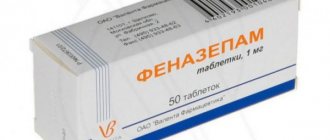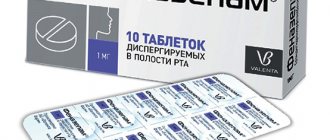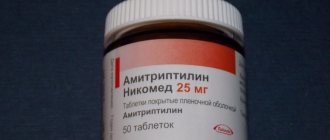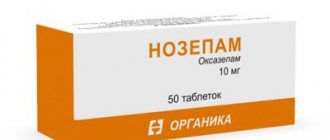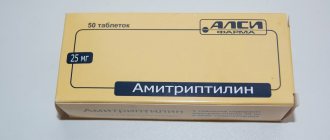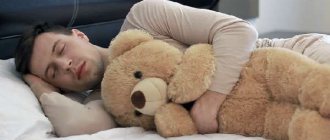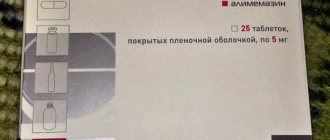Topic: Amitriptyline + phenazepam
Amitriptyline was prescribed, 1 t. 2 r. per day, at night 1-2 tons of phenazepam. Has anyone taken these drugs together? What are your impressions?
You seem to have problems. I took such a set, I can say that after this you need sleep and rest. You will be temporarily disconnected from all problems. This sometimes heals the psyche. Be healthy!
What are you treating? At least tell me first! Did your Doctor tell you the diagnosis? If not, then at least write your complaints! In my opinion, monotherapy with Ametriptyline (which is a tricyclic antidepressant) is a technique of the last century, long outdated; today there are a lot of new and more effective antidepressants and with a much smaller range of side effects! And Amitriptyline in modern psychiatry is prescribed as a combination therapy in combination with one of the Antidepressants of other groups! Now, as for Phenozepam, it is a benzodiazepine tranquilizer, very powerful, which is prescribed in a short course (no more than 2-3 weeks) as a cover for an Antidepressant (well, in your case, it looks like it was prescribed specifically for cover), to treat - it does not cure anything, it is only temporary relieves symptoms or side effects of antidepressants, such as increased anxiety, fears, etc. Phenozepam, when taken for a long time, can form a strong physical and psychological dependence from which it will be very difficult to get rid of in the future! In simple words, he is able to turn an ordinary person into a benzodiazepine addict! In my opinion, it is much safer to hide behind Anxiolytics without addictive potential, from which dependence does not develop, but they are not as strong as benzodiazepine tranquilizers!
Hello, would you at least tell me your diagnosis, if you don’t know, at least write your complaints, oh well, as for your question, Amintiprtyline is an old tricyclic antidepressant, now Psychiatry in its arsenal has a huge number of modern antidepressants that are much newer than Amitriptyline, stronger and with fewer side effects! Amitriptyline is good not as monotherapy, but in combination with one of the antidepressants of other groups, and it is also a night antidepressant, and again, it can be very useful, but not as monotherapy, but the way you are treated is a thing of the past! Now, as for Phenozepam, Phenozepam is a powerful benzodiazepine tranquilizer, which is prescribed in a short course (no more than 2-3 weeks, otherwise, with long-term use, it causes severe physical and psychological dependence, in other words, withdrawal!) In your case, it They were most likely prescribed to cover up the Antidepressant Amitriptyline, you can cover up with it, of course, but the main thing is not to exceed the permissible time limits, and it is better, of course, to use Anxiolytics without addictive potential to cover up, they can be taken as much as you like and they do not cause any dependence, but they are not as strong as benzodiazepine tranquilizers!
Phenazepam is a very weak drug, compared to amitriptyline, it combines many things, including this, the question is, what is it for? To sleep better? There are stronger drugs, for example Reladorm or Seduxen. But subjectively, phenazepam does not work at all amitriptyline is felt immediately, but there were no side effects, but decide for yourself based on how you feel.
I took these drugs, but not together. I took fluosetine together with phenozepam. I tolerated it well. but I took half a tablet of phenozepam at night for 20 days, otherwise addiction and side effects may occur. Half a tablet was enough for me, but 2 tablets seemed like a lot to me. This winter I took amitriptyline. The side effects started. I took 1 tablet a day, drowsiness began, although I drank it at night, then my limbs began to get cold and I stopped drinking it, and I didn’t notice a positive effect from it, fluoxetine suited me better, as well as a more harmless sedative, and also the nootropic tenoten also helps quite well, well, of course, it depends on what for need to be taken and what diagnosis. In general, I would not recommend amitripteline and I would not recommend phenozepam at this dose either.
The doctor should decide, not the patient. He determines the dose of the drug, the frequency of its administration based on the patient’s condition and the severity of the problem.
Oh, how wrong you are, Dr. Sobol, sometimes a lot depends on the patient, and the doctor’s job in quiet situations is to shut up in time. Sometimes a doctor’s word is nothing, but this is the case if he has driven the patient to the brink and continues in the same spirit, not noticing how far everything has gone and not recognizing that he himself is a narrow-minded person!
You probably know more about psychiatry than I do.
Most likely, Dr. Sobol, I really know more about psychiatry than you do. I am a 3rd year medical student studying to become a psychiatrist, I remember in April we wrote a test of 195 questions, I had a result of 138 correct and 57 incorrect answers and I received seven points. I also have a friend who recently went into practice and is slowly getting involved in his work, he told me that disagreements often arise between a doctor and a patient due to the fact that for a long time patients cannot be cured, they get worse and worse, and he Doctors-colleagues, more “experienced”, continue to shout that they “know” everything, have shut the mouths of all patients in the hospital, walk around proud and point blank do not notice that their patients are being hurt by themselves. Some ask to be discharged home if this happens business, they express regret that they came to the hospital, and these “doctors” shut everyone’s mouths, they say, you understand.. Oh, God forbid I have such undemocratic and stupid colleagues.
Your results, Spider200, are amazing, but still do not give you the right to be rude to a doctor who has been working in his specialty longer than you have been alive in this world.
Phenazepam compatibility with alcohol and consequences
Phenazepam is a benzodiazepine tranquilizer, widely used in the practice of many doctors. Its main advantages are proven effectiveness and accessibility. It is the drug of choice for mental and neurological diseases, various types of substance addiction, and in many other cases. But the drug also has negative sides.
Phenazepam has a large number of side effects and contraindications. The most common side effect is drowsiness, but bradycardia, decreased blood pressure, dyspeptic disorders and much more also occur. A wide range of contraindications includes both certain diseases of internal organs and use in combination with other substances.
The compatibility of phenazepam with alcohol has been most studied. The fact is that the drug is used in the treatment of alcohol addiction. Some patients, after prescribing the drug, violate the instructions: they continue to drink alcohol, which causes a number of negative consequences, which are currently well studied.
Alcohol and phenazepam are completely incompatible with each other. The use of these two substances at the same time is strictly contraindicated. Neglecting these rules sometimes ends in death.
Comparison of side effects of Grandaxin and Fluoxetine
Side effects or adverse events are any adverse medical event that occurs in a subject after administration of a drug.
Fluoxetine has more adverse effects than Grandaxin. This implies that the frequency of their occurrence is low with Fluoxetine and low with Grandaxin. Frequency of manifestation is an indicator of how many cases of an undesirable effect from treatment are possible and registered. The undesirable effect on the body, the strength of influence and the toxic effect of drugs are different: how quickly the body recovers after taking it and whether it recovers at all. When using Fluoxetine, the body's ability to recover faster is higher than that of Grandaxin.
Reasons for incompatibility
Phenazepam, like all benzodiazepine tranquilizers, increases the amount of inhibitory transmitters in the neurons of the central nervous system. This leads to inhibition of the activity of nerve cells and causes a sedative effect.
Ethanol has a similar effect. Its breakdown products are toxic to brain cells. First, they increase the concentration of substances responsible for pleasure, and then inhibit the activity of all central nervous system centers. The greater the dose of alcohol, the stronger the depression.
Phenazepam and alcohol potentiate each other's effects. However, the effect is not limited to conventional sedation. Any centers of the brain may stop functioning, including those responsible for vital functions. Drinking even small amounts of alcohol in combination with low doses of phenazepam can lead to significant depression of central nervous system cells.
Comparison of the safety of Grandaxin and Fluoxetine
The safety of a drug includes many factors.
At the same time, in Grandaxin it is quite similar to Fluoxetine. It is important where the drug is metabolized: drugs are excreted from the body either unchanged or in the form of products of their biochemical transformations. Metabolism occurs spontaneously, but most often involves major organs such as the liver, kidneys, lungs, skin, brain and others. When assessing the metabolism of Grandaxin, as well as Fluoxetine, we look at which organ is the metabolizing organ and how critical the effect on it is.
The risk-benefit ratio is when the prescription of a drug is undesirable, but justified under certain conditions and circumstances, with the obligatory observance of caution in use. At the same time, Grandaxin does not have any risks when used, just like Fluoxetine.
Also, when calculating safety, it is taken into account whether only allergic reactions occur or possible dysfunction of the main organs. In other matters, as well as the reversibility of the consequences of using Grandaxin and Fluoxetine.
Consequences of taking phenazepam and alcohol
The specific consequences depend on the dosage of the drug, the amount of alcohol and the sensitivity of the patient's body. Most often, general depression develops - confusion, stupor, stupor, coma, pathological drowsiness.
From the cardiovascular system, there is a pronounced decrease in heart rate and a drop in blood pressure. Reduced breathing may occur. Sometimes paradoxical reactions occur associated with hyperexcitation of the cerebral cortex and subcortical structures. Such reactions are called pathological intoxication.
Pathological intoxication is the development of symptoms of mental illness when drinking a small amount of alcohol. Accompanied by hallucinations, delusions, motor activity, and confusion. Sometimes convulsions develop, similar to an epileptic attack.
An overdose of phenazepam while drinking alcohol can result in death. The lethal dose of phenazepam is 10 mg.
Treatment of alcoholism with phenazepam
Phenazepam is used to treat alcohol withdrawal, popularly called “withdrawal.” Withdrawal syndrome occurs a few days after the complete cessation of alcohol consumption in people who have been abusing them for a long time. It is manifested by attacks of aggression, agitation, unreasonable excitement, hallucinations, and delusions. This condition is treated with tranquilizers and other sedatives.
Phenazepam is often the drug of choice because it is highly effective and low cost. You can use this remedy for alcohol dependence, but you should not mix it with alcohol. To exclude the interaction of two substances, a certain scheme is used.
Contrary to popular belief, alcoholism cannot be cured with phenazepam. This drug only helps fight the symptoms that occur in addicts when withdrawing from alcohol.
special instructions
In severe depressive conditions, it is recommended to be careful when using the drug. Because this can increase suicidal symptoms.
It is also necessary to be careful when using the drug in weakened patients, as well as in the elderly.
With long-term treatment, as well as when using the drug for renal and liver failure, it is necessary to monitor the peripheral blood picture and the activity of liver enzymes.
Be sure to read:
Tabex: instructions for use for quitting smoking
After long-term use or abrupt cessation of use of the drug, the following conditions may be observed: severe depression, thoughts of suicide, increased seizures, hallucinations, shallow sleep. In this case, treatment must be stopped.
During treatment with Phenazepam, it is recommended to drive with extreme caution. The same applies to other activities that require quick reaction and concentration.
Instructions for using phenazepam with alcohol
Phenazepam is prescribed when alcohol withdrawal syndrome develops. This happens after it is completely removed from the body. In this case, the danger of interaction is eliminated. If the drug is prescribed to someone who is currently abusing alcohol, you should wait 2 days after drinking alcohol.
If, on the contrary, the patient wants to drink alcohol during treatment with phenazepam, regardless of the reasons for its prescription, you should wait a few days. The half-life of the drug is 12 hours. This means that after 12 hours, half of the dose taken will remain in the blood. After another 12 hours - half half and so on. Considering this fact and therapeutic doses, we can say that you should drink alcohol no less than 2-3 days after stopping treatment with phenazepam.
At the same time, it is worth remembering that you cannot stop taking the drug at once. Side effects may also develop when phenazepam is discontinued. First, gradually reduce the dose of the medication, then stop taking it completely, wait at least 2 days, after which you can drink alcohol. However, discontinuation of the drug must be agreed with the attending physician. Stopping treatment on your own can lead to serious consequences.
Comparison of the effectiveness of Grandaxin and Fluoxetine
The effectiveness of Grandaxin is quite similar to Fluoxetine - this means that the ability of the drug to provide the maximum possible effect is similar.
For example, if the therapeutic effect of Grandaxin is more pronounced, then using Fluoxetine even in large doses will not achieve this effect.
Also, the speed of therapy - an indicator of the speed of therapeutic action - is approximately the same for Grandaxin and Fluoxetine. And bioavailability, that is, the amount of a drug reaching its site of action in the body, is similar. The higher the bioavailability, the less it will be lost during absorption and use by the body.
Reviews
Ilya E .: “I was treated by a narcologist for a long time about alcohol addiction. I couldn’t bear the lack of my favorite drinks very well, so I took phenazepam. The drug helped me cope with a difficult period in my life. It suppresses irritability and calms well. I took it while I was in a bind. An excellent incentive not to drink, I saw what happens to those who drink phenazepam and alcohol at the same time. Apparently, they felt very bad, so I didn’t drink. Phenazepam helped me cope.”
Kirill M .: “I took phenazepam prescribed by the doctor. I was warned not to drink alcohol, but I didn't take it seriously. This is how they talk about many drugs, and nothing happens. During the course of treatment I had the imprudence to drink a glass of beer with friends. I don’t know what happened to me next. 4 days fell out of my life. As it turned out, I spent them in intensive care in an unconscious state. I stopped taking Phenazepam, now I’m afraid.”
Review from a narcologist : “I often use phenazepam in the treatment of alcohol withdrawal. The drug is very effective, especially in patients with agitation, attacks of aggression, and insomnia. Phenazepam eliminates all these symptoms quite quickly. The only downside is that you need to closely monitor the patient. Many patients break down and drink alcohol, despite the ban. The consequences can be different, including death. I prescribe phenazepam only to those patients who are in the hospital, since they can be controlled, and I treat them on an outpatient basis with other medications.”
Comparison of ease of use of Grandaxin and Fluoxetine
This includes dose selection taking into account various conditions and frequency of doses. At the same time, it is important not to forget about the release form of the drug; it is also important to take it into account when making an assessment.
The ease of use of Grandaxin is approximately the same as Fluoxetine. However, they are not convenient enough to use.
The drug ratings were compiled by experienced pharmacists who studied international research. The report is generated automatically.
Last update date: 2019-09-19 05:59:55
Phenazepam analogues: comparison of drugs and list of over-the-counter products
Phenazepam is a strong medication that can have a pronounced effect on the human psyche. It belongs to the pharmacological group of tranquilizers and is capable of causing hypnotic, muscle relaxant and antiepileptic effects. This drug should be prescribed only under the supervision of a physician of the appropriate specialty, as there is a risk of complications and adverse reactions in response to its use. If for some reason the drug Phenazepam is not suitable for you, analogues for selecting and prescribing a new treatment regimen should only be selected together with the treating doctor, who is well acquainted with the features of the clinical case. Never self-medicate, because an incorrectly selected pharmaceutical drug or dosage can cause irreparable harm to your health.
Analogs
Modern pharmaceuticals are developing rapidly, constantly developing and launching new medicines. That is why you can easily find a huge variety of drugs that would have an effect similar to Phenazepam and could become its worthy replacement.
You can find analogues that have the same active ingredient in their composition, you can choose a substitute from the same pharmaceutical group (tranquilizers), but with a different main component. Sometimes it is necessary to switch to a drug with a fundamentally different mechanism of action.
When selecting a new treatment regimen, you must first of all be guided by the reason why you had to stop using Phenazepam. You also need to focus on the severity of the disease and the particular etiology of the disease in the patient. In some cases, the financial aspect is also important, and then you need to try to choose more affordable medicines.
Grandaxin or Phenazepam: which is better?
The therapeutic effect of Grandaxin is based on the active substance tofisopam, which has a milder effect and does not have such a strong effect on a person’s mental state (in some cases this is required). Another advantage of Grandixin is that it does not cause addiction and dependence, unlike Phenazepam, and does not lead to the development of “withdrawal syndrome” in case of abrupt cessation of taking the pills. Gandaxin does not affect muscle tone (there is no muscle relaxant effect), and therefore it can be used in patients with myasthenia gravis. For Phenazepam, this disease is a strict contraindication.
Amitriptyline and Phenazepam: comparative characteristics
Amitriptyline belongs to the group of antidepressants, and therefore its effect is significantly different from the effects of Phenazepam, which is a tranquilizer. Amitriptyline has a pronounced sedative effect and is widely used to treat depressive disorders of various origins. In addition, this medication can be effective for delusional disorders, nocturnal enuresis, and bulimia nervosa.
Amitriptyline is prescribed to patients with cancer to eliminate chronic pain syndrome. The combined use of this tranquilizer and antidepressant is possible. However, their simultaneous use requires special care and monitoring by a doctor.
Phenibut as an analogue
Phenibut belongs to the group of anxiolytics and, like Phenazepam, is capable of eliminating anxious mental disorders and stopping causeless fear. In addition, Phenibut, being a derivative of gamma-aminobutyric acid, has a nootropic effect, that is, it is able to improve and accelerate metabolic processes in brain tissue.
Amitriptyline and phenazepam: can they be taken at the same time (compatibility)
The combined use of Amitriptyline and Phenazepam is often used in medical practice. The combination of the effects of different drugs can improve the effectiveness of treatment in eliminating emotional and mental disorders.
Amitriptyline is often used together with Phenazepam.
Characteristics of Amitriptyline
The drug is a psychotropic drug belonging to the group of tricyclic antidepressants. When used, the medicine gives sedative, hypnotic and anticonvulsant effects.
The drug directly affects brain cells. During the development of a depressive state, the release of serotonin and norepinephrine, which are responsible for improving the emotional background, decreases. Amitriptyline prevents the reabsorption of these substances into the nerve cells of the brain.
The therapeutic substance eliminates anxiety and fear, helps to elevate mood. The effect of using the drug is observed 20-30 days after the start of the course of treatment.
Amitriptyline has a hypnotic effect.
How does Phenazepam work?
The drug contains the active substance bromodihydrochlorophenylbenzodiazepine, which has an anxiolytic effect. The tranquilizer has a calming effect on the body, normalizes sleep, relaxes and relieves tension.
The drug effectively reduces the excitability of the subcortical structures of the brain (thalamus, hypothalamus, limbic system).
Combined effect of Amitriptyline and Phenazepam
As a result of the simultaneous use of drugs in the body, positive changes occur:
- Increased excitability and tension are relieved:
- feelings of anxiety and fear are reduced;
- panic disorders go away;
- the mechanism of falling asleep is normalized;
- muscles relax;
- bad thoughts are eliminated;
- the feeling of fatigue decreases;
- mood improves.
When medications are used together, mood improves.
Indications for simultaneous use
The reasons for the simultaneous use of drugs in psychiatry are the following disorders:
- neurotic and neurosis-like states, accompanied by increased irritability, nervous tension, fear, emotional lability;
- reactive psychoses;
- depression;
- sleep disturbance;
- the presence of withdrawal syndrome and epilepsy;
- schizophrenia in acute form and remission stages.
Contraindications to Amitriptyline and Phenazepam
The drugs are not approved for use for the following health problems:
- impaired functioning of the kidneys and liver;
- prostate pathology;
- increased intraocular pressure;
- the presence of ulcerative lesions of the gastrointestinal tract;
- severe depression;
- arterial hypertension 3 degrees;
- severe disturbances in the functioning of the heart;
- myasthenic syndrome.
Medicines are not used in the presence of individual intolerance to individual therapeutic components of the drug, acute alcohol and drug intoxication, or decreased respiratory function.
The drugs are prohibited for treatment during pregnancy and breastfeeding. They are not used in the treatment of children.
How to take Amitriptyline and Phenazepam
Amitriptyline tablets are taken before bed. The initial therapeutic dose is 25-50 mg. If the effect is insufficient, the dosage is increased, but it should not exceed 300 mg.
The medicinal solution is administered intramuscularly 2-3 times a day in an amount of 50-100 mg. In severe cases, the use of 400 mg of the drug is allowed.
Phenazepam is prescribed IV, IM and orally. The dosage is determined by the doctor individually and depends on the type of mental disorder and its severity.
Side effects
During treatment with medications, undesirable effects may occur, including:
- development of intestinal atony;
- feeling of weakness and fatigue;
- disturbances in heart rhythm;
- loss of appetite;
- digestive system disorders;
- changes in the quantitative composition of blood;
- the appearance of an allergic rash;
- weakening of sexual desire;
- memory loss;
- violation of motor and speech functions.
Long-term use of drugs can form drug dependence.
Doctors' opinion
With combination therapy with Phenazepam and Amitriptyline, the treatment is highly effective. Practitioners pay attention to the availability of drugs because of their low price.
Many psychiatrists introduce medications into the course of treatment to eliminate mental attacks, anxiety, insomnia, and alcohol disorders.
But doctors point out the need for treatment with drugs under the supervision of a specialist, because medications cause numerous side effects. During therapy, addiction to the active substance is also possible, so it is recommended not to use the medicines for more than 3 months.
